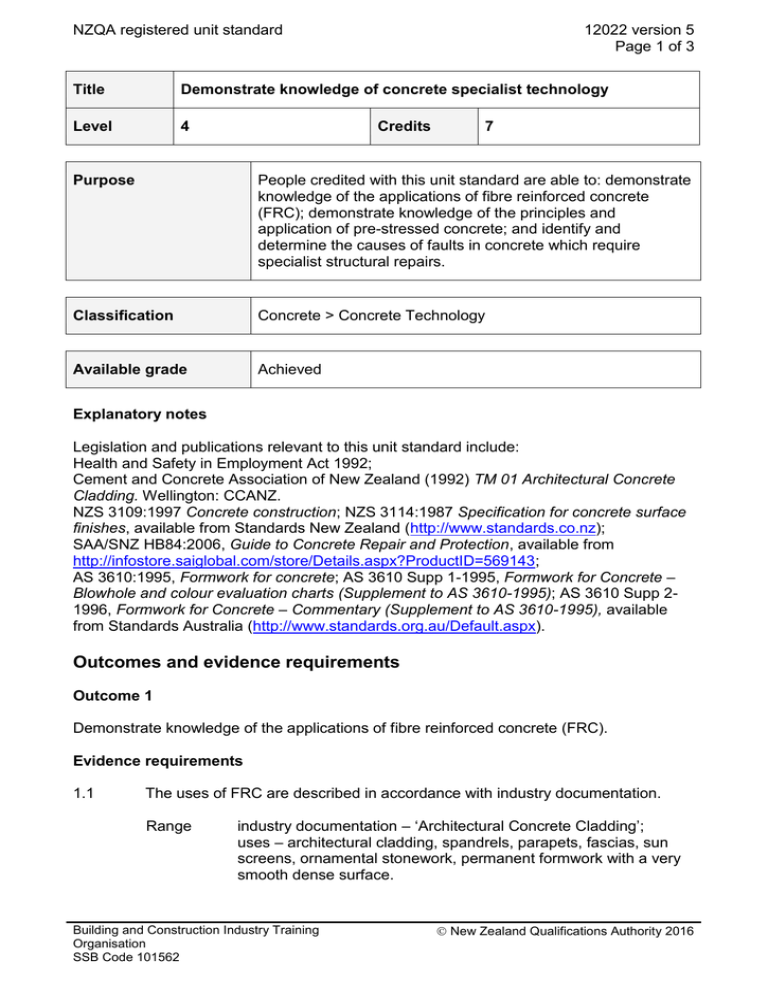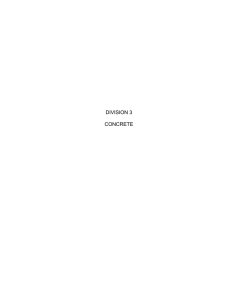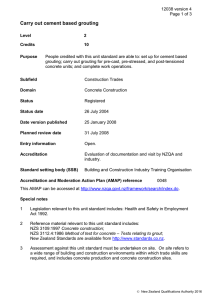NZQA registered unit standard 12022 version 5 Page 1 of 3
advertisement

NZQA registered unit standard 12022 version 5 Page 1 of 3 Title Demonstrate knowledge of concrete specialist technology Level 4 Credits 7 Purpose People credited with this unit standard are able to: demonstrate knowledge of the applications of fibre reinforced concrete (FRC); demonstrate knowledge of the principles and application of pre-stressed concrete; and identify and determine the causes of faults in concrete which require specialist structural repairs. Classification Concrete > Concrete Technology Available grade Achieved Explanatory notes Legislation and publications relevant to this unit standard include: Health and Safety in Employment Act 1992; Cement and Concrete Association of New Zealand (1992) TM 01 Architectural Concrete Cladding. Wellington: CCANZ. NZS 3109:1997 Concrete construction; NZS 3114:1987 Specification for concrete surface finishes, available from Standards New Zealand (http://www.standards.co.nz); SAA/SNZ HB84:2006, Guide to Concrete Repair and Protection, available from http://infostore.saiglobal.com/store/Details.aspx?ProductID=569143; AS 3610:1995, Formwork for concrete; AS 3610 Supp 1-1995, Formwork for Concrete – Blowhole and colour evaluation charts (Supplement to AS 3610-1995); AS 3610 Supp 21996, Formwork for Concrete – Commentary (Supplement to AS 3610-1995), available from Standards Australia (http://www.standards.org.au/Default.aspx). Outcomes and evidence requirements Outcome 1 Demonstrate knowledge of the applications of fibre reinforced concrete (FRC). Evidence requirements 1.1 The uses of FRC are described in accordance with industry documentation. Range industry documentation – ‘Architectural Concrete Cladding’; uses – architectural cladding, spandrels, parapets, fascias, sun screens, ornamental stonework, permanent formwork with a very smooth dense surface. Building and Construction Industry Training Organisation SSB Code 101562 New Zealand Qualifications Authority 2016 NZQA registered unit standard 12022 version 5 Page 2 of 3 1.2 Description outlines the composition of FRC in accordance with industry documentation. 1.3 Description outlines the method of manufacture of FRC in accordance with industry documentation. 1.4 Description outlines the hazards associated with, and hazard control procedures required for, the handling and use of FRC. Outcome 2 Demonstrate knowledge of the principles and application of pre-stressed concrete. Evidence requirements 2.1 Description outlines items of pre-stressing equipment and the purpose of each. Range materials and equipment – barrels, wedges, hydraulic jacks, strands. 2.2 Description outlines the principles of pre-stressing concrete in accordance with NZS 3109. 2.3 Description outlines the methods and systems of stressing in accordance with NZS 3109. 2.4 Description outlines the differences between the tensile properties of prestressing strand and reinforcing steel. 2.5 Description outlines the purpose of and methods for grouting stressing ducts and the associated hazards in accordance with NZS 3109. 2.6 Description outlines the specification requirements for grout and methods of testing in accordance with NZS 3109. Outcome 3 Identify and determine the causes of faults in concrete which require specialist structural repairs. Evidence requirements 3.1 Causes of structural faults are identified in accordance with SAA/SNZ HB84:2006. Range causes of structural faults – deficiencies in design, damage caused by explosion, fire, impact, overloading, earthquake or foundation settlement, deterioration by environmental attack not foreseen by the specifier, lack of temporary propping. Building and Construction Industry Training Organisation SSB Code 101562 New Zealand Qualifications Authority 2016 NZQA registered unit standard 3.2 12022 version 5 Page 3 of 3 Structural faults in concrete are identified in accordance with SAA/SNZ HB84:2006. structural faults – cracking, blowholes, poor compaction, chipping, spalling, severe impact damage. Range Planned review date 31 December 2013 Status information and last date for assessment for superseded versions Process Version Date Last Date for Assessment Registration 1 21 May 1999 N/A Revision 2 12 February 2003 N/A Review 3 26 July 2004 N/A Rollover and Revision 4 25 January 2008 N/A Rollover and Revision 5 17 November 2011 N/A Consent and Moderation Requirements (CMR) reference 0048 This CMR can be accessed at http://www.nzqa.govt.nz/framework/search/index.do. Please note Providers must be granted consent to assess against standards (accredited) by NZQA, before they can report credits from assessment against unit standards or deliver courses of study leading to that assessment. Industry Training Organisations must be granted consent to assess against standards by NZQA before they can register credits from assessment against unit standards. Providers and Industry Training Organisations, which have been granted consent and which are assessing against unit standards must engage with the moderation system that applies to those standards. Requirements for consent to assess and an outline of the moderation system that applies to this standard are outlined in the Consent and Moderation Requirements (CMR). The CMR also includes useful information about special requirements for organisations wishing to develop education and training programmes, such as minimum qualifications for tutors and assessors, and special resource requirements. Comments on this unit standard Please contact the Building and Construction Industry Training Organisation national.office@bcito.org.nz if you wish to suggest changes to the content of this unit standard. Building and Construction Industry Training Organisation SSB Code 101562 New Zealand Qualifications Authority 2016





